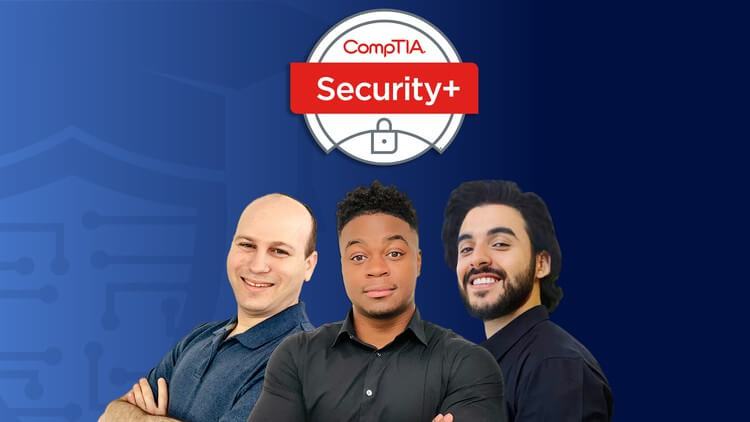Embark on a comprehensive learning journey with our free video course, the “[ZerotoMastery] CompTIA Security+ Certification Bootcamp,” exclusively available on “howtofree.org.” Dive into over 30 hours of expertly crafted video content designed to guide you through the intricacies of CompTIA Security+ certification.
Delivered by seasoned experts, the course provides a deep dive into cybersecurity essentials, offering practical insights and strategies for success. Whether you’re a beginner or seeking to enhance your existing skills, this bootcamp is tailored to meet you at your current level and guide you towards mastery.
Table of Contents
Equip yourself with the knowledge and skills demanded by the ever-evolving field of cybersecurity. Join us on this empowering journey, and elevate your career prospects by conquering the CompTIA Security+ exam. Seize the opportunity to learn for free – enroll now and take a significant step towards securing your future in the dynamic world of cybersecurity.
What You Will Learn:
- Fundamental Security Concepts:
- Acquire a solid understanding of foundational security concepts to build a robust knowledge base.
- Navigating Threats, Vulnerabilities, & Remedies:
- Learn to effectively navigate and address threats and vulnerabilities, with a focus on practical remedies.
- Decoding Security Architecture:
- Uncover the intricacies of security architecture, gaining insights into its components and functionalities.
- Mastering Security Operations:
- Master the art of security operations, developing skills crucial for effective security management.
- Guiding Security Program Management & Oversight:
- Gain the expertise to guide and oversee security program management, ensuring comprehensive and effective security measures.
Course Content of CompTIA Security+ Certification Bootcamp
1. Introduction
- Welcome to the Course!
- Download the Study Guide
- Exam Tips
- Checkpoint: Introduction
2. Fundamentals of Security
- Fundamentals of Security.
- Threats and Vulnerabilities
- 1.2)
- 1.2)
- Non-repudiation (OBJ 1.2)
- Authentication (OBJ 1.2)
- Authorization (OBJ 1.2)
- Accounting (OBJ 1.2)
- Security Control Categories (OBJ 1.1)
- Security Control Types (OBJ 1.1)
- Gap Analysis (OBJ 1.1)
- Zero Trust (OBJ 1.2)
- Checkpoint: Fundamentals of Security
3. Threat Actors
- Lhreat Actors (OBJ
- Threat Actor Motivations (OBJ 2.1)
- Threat Actor Attributes (OBJ 2.1)
- Unskilled Attackers (OBJ 2.1)
- Hacktivists (OBJ 2.1)
- Organized Crime (OBJ 2.1)
- Nation-state Actor (OBJ 2.1)
- Insider Threats (OBJ 2.1)
- Shadow IT (OBJ 2.1)
- Threat Vectors and Attack Surfaces (OBJ 2.2)
- Outsmarting Threat Actors (OBJ 1.2)
- Checkpoint: Threat Actors
4. Physical Security
- Physical Security (OBJ 1.2 & 2.4)
- Fencing and Bollards (OBJ 1.2)
- Attacking with Brute Force (OBJ 2.4)
- Surveillance Systems (OBJ 1.2)
- Bypassing Surveillance Systems (OBJ 2.4)
- Access Control Vestibules (OBJ 1.2)
- Door Locks (OBJ 1.2)
- Access Badge Cloning (OBJ 2.4)
- Checkpoint: Physical Security
5. Social Engineering
- Social Engineering (OBJ 2.2 & 5.6)
- Motivational Triggers (OBJ 5.6)
- Impersonation (OBJ 2.2)
- Pretexting (OBJ 2.2)
- Phishing Attacks (OBJ 2.2)
- Preventing Phishing Attacks (OBJ 5.6)
- Conducting an Anti-Phishing Campaign (OBJ 5.6)
- Frauds and Scams (OBJ 2.2)
- Influence Campaigns (OBJ 2.2)
- Other Social Engineering Attacks (OBJ 2.2)
- Checkpoint: Social Engineering
6. Malware
- Malware (OBJ 2.4)
- Viruses (OBJ 2.4)
- Worms (OBJ 2.4)
- Trojans (OBJ 2.4)
- Viruses and Trojans (OBJ 2.4)
- Ransomware (OBJ 2.4)
- Zombies and Botnets (OBJ 2.4)
- Rootkits (OBJ 2.4)
- Backdoors and Logic Bombs (OBJ 2.4)
- Keylogger (OBJ 2.4)
- Spyware and Bloatware (OBJ 2.4)
- Malware Attack Techniques (OBJ 2.4)
- Indications of Malware Attacks (OBJ 2.4)
- Checkpoint: Malware
7. Data Protection
- Data Protection (OBJ 1.4, 3.3, 4.2, 4.4, & 5.1)
- Data Classifications (OBJ 3.3)
- Data Ownership (OBJ 4.2 & 5.1)
- Data States (OBJ 3.3)
- Data Types (OBJ 3.3 & 1.4)
- Data Sovereignty (OBJ 3.3)
- Securing Data (OBJ 3.3)
- Data Loss Prevention (DLP) (OBJ 4.4)
- Configuring a DLP (OBJ 4.5)
- Checkpoint: Data Protection
8. Cryptographic Solutions
- Cryptographic Solutions (OBJ 1.4, 2.3, & 2.4)
- Symmetric vs Asymmetric (OBJ 1.4)
- Symmetric Algorithms (OBJ 1.4)
- Asymmetric Algorithms (OBJ 1.4)
- Hashing (OBJ 1.4)
- Increasing Hash Security (OBJ 1.4)
- Public Key Infrastructure (PKI) (OBJ 1.4)
- Digital Certificates (OBJ 1.4)
- Exploring Digital Certificates (OBJ 1.4)
- Blockchain (OBJ 1.4)
- Encryption Tools (OBJ 1.4)
- Obfuscation (OBJ 1.4)
- Cryptographic Attacks (OBJ 2.3 & 2.4)
- Checkpoint: Cryptographic Solutions
9. Risk Management
- Risk Management (OBJ 5.2)
- Risk Assessment Frequency (OBJ 5.2)
- Risk Identification (OBJ 5.2)
- Risk Register (OBJ 5.2)
- Qualitative Risk Analysis (OBJ 5.2)
- Quantitative Risk Analysis (OBJ 5.2)
- Risk Management Strategies (OBJ 5.2)
- Risk Monitoring and Reporting (OBJ 5.2)
- Checkpoint: Risk Management
10. Third-party Vendor Risks
- Third-party Vendor Risks (OBJ 2.2, 2.3, & 5.3)
- supply Chain Risks (OBJ 2.3 & 5.3)
- Supply Chain Attacks (OBJ 2.2 & 5.3)
- Vendor Assessment (OBJ 5.3)
- Vendor Selection and Monitoring (OBJ 5.3)
- Contracts and Agreements (OBJ 5.3)
- Checkpoint: Third-party Vendor Risks
11. Governance and Compliance
- Governance and Compliance (OBJ 5.1 & 5.4)
- Governance (OBJ 5.1)
- Governance Structures (OBJ 5.1)
- Policies (OBJ 5.1)
- Standards (OBJ 5.1)
- Procedures (OBJ 5.1)
- Governance Considerations (OBJ 5.1)
- Compliance (OBJ 5.4)
- Non-compliance Consequences (OBJ 5.4)
- Checkpoint: Governance and Compliance
12. Asset and Change Management
- Asset and Change Management (OBJ 1.3, 4.1, & 4.2)
- Acquisition and Procurement (OBJ 4.2)
- Mobile Asset Deployments (OBJ 4.1)
- Asset Management (OBJ 4.2)
- Asset Disposal and Decommissioning (OBJ 4.2)
- Change Management (OBJ 1.3)
- Change Management Processes (OBJ 1.3)
- Technical Implications of Changes (OBJ 1.3)
- Documenting Changes (OBJ 1.3)
- Checkpoint: Asset and Change Management
13. Audits and Assessments
- Audits and Assessments (OBJ 5.5)
- Internal Audits and Assessments (OBJ 5.5)
- Performing an Internal Assessment (OBJ 5.5)
- External Audits and Assessments (OBJ 5.5)
- Performing an External Assessment (OBJ 5.5)
- Penetration Testing (OBJ 5.5)
- Reconnaissance in Pentesting (OBJ 5.5)
- Performing a Basic PenTest (OBJ 5.5)
- Attestation of Findings (OBJ 5.5)
- Checkpoint: Audits and Assessments
14. Cyber Resilience and Redundancy
- Cyber Resilience and Redundancy (OBJ 3.4)
- High Availability (OBJ 3.4)
- Data Redundancy (OBJ 3.4)
- Configuring a RAID (OBJ 3.4)
- Capacity Planning (OBJ 3.4)
- Powering Data Centers (OBJ 3.4)
- Data Backups (OBJ 3.4)
- Continuity of Operations Plan (OBJ 3.4)
- Redundant Site Considerations (OBJ 3.4)
- Resilience and Recovery Testing (OBJ 3.4)
- Checkpoint: Cyber Resilience and Redundancy
15. Secu rity Arch itecture
- Security Architecture (OBJ 3.1 & 4.1)
- On-premise versus the Cloud (OBJ 3.1)
- Cloud Security (OBJ 3.1&4.1)
- Virtualization and Containerization (OBJ 2.3 & 3.1)
- Serverless (OBJ 3.1)
- Microservices (OBJ 3.1)
- Network Infrastructure (OBJ 3.1)
- Software-Defined Network (SDN) (OBJ 3.1)
- Infrastructure as Code (laC) (OBJ 3.1)
- Centralized vs Decentralized Architectures (OBJ 3.1)
- Internet of Things (IOT) (OBJ 3.1 & 4.1)
- lcs and SCADA (OBJ 3.1 & 4.1)
- Embedded Systems (OBJ 3.1 & 4.1)
- Checkpoint: Security Architecture
16. Security Infrastructure
- Security Infrastructure (OBJ 3.2 & 4.5)
- Ports and Protocols (OBJ 4.5)
- Firewalls (OBJ 3.2)
- Configuring Firewalls (OBJ 4.5)
- IDS and IPS (OBJ 3.2)
- Network Appliances (OBJ 3.2)
- Port Security (OBJ 3.2)
- Securing Network Communications (OBJ 3.2)
- SD-WAN and SASE (OBJ 3.2)
- Infrastructure Considerations (OBJ 3.2)
- Selecting Infrastructure Controls (OBJ 3.2)
- Checkpoint: Security Infrastructure
17. Identity and Access Management (‘AM) Solutions
- Identity and Access Management (IAM) Solutions (OBJ 2.4 & 4.6)
- Identity and Access Management (IAM) (OBJ 4.6)
- Multifactor Authentication (OBJ 4.6)
- Password Security (OBJ 4.6)
- Password Attacks (OBJ 2.4)
- Single Sign-on (SSO) (OBJ 4.6)
- Federation (OBJ 4.6)
- Privileged Access Management (PAM) (OBJ 4.6)
- Access Control Models (OBJ 4.6)
- Assigning Permissions (OBJ 4.6)
- Checkpoint: Identity and Access Management (IAM) Solutions
18. Vulnerabilities and Attacks
- Vulnerabilities and Attacks (OBJ 2.2, 2.3, 2.4, 2.5, & 4.1)
- Hardware Vulnerabilities (OBJ 2.2, 2.3, & 2.5)
- Bluetooth Vulnerabilities and Attacks (OBJ 2.3, 2.5, & 4.1)
- Mobile Vulnerabilities and Attacks (OBJ 2.3, 2.5, & 4.1)
- Zero-day Vulnerabilities (OBJ 2.3)
- Operating System Vulnerabilities (OBJ 2.3 & 2.5)
- SQL and XML Injections (OBJ 2.3 & 2.4)
- Conducting an SQL Injection (OBJ 2.3 & 2.4)
- XSS and XSRF (OBJ 2.3 & 2.4)
- Buffer Overflow (OBJ 2.3 & 2.4)
- Race Conditions (OBJ 2.3)
- Checkpoint: Vulnerabilities and Attacks
19. Malicious Activity
- Malicious Activity (OBJ 2.4)
- Distributed Denial of Service (OBJ 2.4)
- Domain Name System (DNS) Attacks (OBJ 2.4)
- Directory Traversal Attack (OBJ 2.4)
- Execution and Escalation Attack (OBJ 2.4)
- Replay Attacks (OBJ 2.4)
- Session Hijacking (OBJ 2.4)
- On-Path Attacks
- Injection Attacks
- Indicators of Compromise (IOC)
- Checkpoint: Malicious Activity
20. Hardening
- Hardening (OBJ 2.5, 4.1, & 4.5)
- Changing Default Configurations (OBJ 2.5)
- Restricting Applications (OBJ 2.5)
- Unnecessary Services (OBJ 2.5)
- Trusted Operating Systems (OBJ 2.5)
- Updates and Patches (OBJ 2.5)
- Patch Management (OBJ 2.5)
- Group Policies (OBJ 2.5 & 4.5)
- SELinux (OBJ 2.5&4.5)
- Data Encryption Levels (2.5)
- Secure Baselines (OBJ 2.5 and 4.1)
- Checkpoint: Hardening
21. Security Techniques
- Security Techniques (OBJ 4.1 & 4.5)
- Wireless Infrastructure Security (OBJ 4.1)
- Wireless Security Settings (OBJ 4.1)
- Application Security (OBJ 4.1)
- Network Access Control (NAC) (OBJ 4.5)
- Web and DNS Filtering (OBJ 4.5)
- Email Security (OBJ 4.5)
- Endpoint Detection and Response (OBJ 4.5)
- User Behavior Analytics (OBJ 4.5)
- Selecting Secure Protocols (OBJ 4.5)
- Checkpoint: Security Techniques
22. Vulnerability Management
- Vulnerability Management (OBJ 4.3)
- Identifying Vulnerabilities (OBJ 4.3)
- Threat Intelligence Feeds (OBJ 4.3)
- Responsible Disclosure Programs (OBJ 4.3)
- Analyzing Vulnerabilities (OBJ 4.3)
- Conducting Vulnerability Scans (OBJ 4.3)
- Assessing Vulnerability Scan Results (OBJ 4.3)
- Vulnerability Response and Remediation (OBJ 4.3)
- Validating Vulnerability Remediation (OBJ 4.3)
- Vulnerability Reporting (OBJ 4.3)
- Checkpoint: Vulnerability Management
23. Alerting and Monitoring
- Alerting and Monitoring (OBJ 4.4)
- Monitoring Resources (OBJ 4.4)
- Alerting and Monitoring Activities (OBJ 4.4)
- Simple Network Management Protocol (SNMP) (OBJ 4.4)
- Security Information and Event Management (SIEM) (OBJ 4.4)
- Data from Security Tools (OBJ 4.4)
- Security Content Automation and Protocol (SCAP) (OBJ 4.4)
- NetFlow and Flow Analysis
- Single Pane of Glass (OBJ 4.4)
- Checkpoint: Alerting and Monitoring
24. Incident Response of CompTIA Security+ Certification Bootcamp
- Incident Response (OBJ 4.8)
- Incident Response Process (OBJ 4.8)
- Threat Hunting (OBJ 4.8)
- Root Cause Analysis (OBJ 4.8)
- Incident Response Training and Testing (OBJ 4.8)
- Digital Forensic Procedures (OBJ 4.8)
- Data Collection Procedures (OBJ 4.8)
- Disk Imaging and Analysis (OBJ 4.8)
- Checkpoint: Incident Response
25. Investigating an Incident
- Investigating an Incident (OBJ 4.9)
- Investigating with Data (OBJ 4.9)
- Dashboards (OBJ 4.9)
- Automated Reports (OBJ 4.9)
- Vulnerability Scans (OBJ 4.9)
- Packet Captures (OBJ 4.9)
- Firewall Logs (OBJ 4.9)
- Application Logs (OBJ 4.9)
- Endpoint Logs (OBJ 4.9)
- OS-specific Security Logs (OBJ 4.9)
- IPS/IDS Logs (OBJ 4.9)
- Network Logs (OBJ 4.9)
- Metadata (OBJ 4.9)
- Checkpoint: Investigating an Incident
26. Automation and Orchestration CompTIA Security+ Certification Bootcamp
- Automation and Orchestration (OBJ 4.7)
- When to Automate and Orchestrate (OBJ 4.7)
- Benefits of Automation and Orchestratation (OBJ 4.7)
- Automating Support Tickets (OBJ 4.7)
- Automating Onboarding (OBJ 4.7)
- Automating Security (OBJ 4.7)
- Automating Application Development (OBJ 4.7)
- Integrations and APIs (OBJ 4.7)
- Checkpoint: Automation and Orchestration
27. Security Awareness CompTIA Security+ Certification Bootcamp
- Security Awareness (OBJ 5.6)
- Recognizing Insider Threats (OBJ 5.6)
- Password Management (OBJ 5.6)
- Avoiding Social Engineering (OBJ 5.6)
- Policy and Handbooks (OBJ 5.6)
- Remote and Hybrid Work Environments (OBJ 5.6)
- Creating a Culture of Security (OBJ 5.6)
- Checkpoint: Security Awareness
28. Conclusion
- Conclusion
- BONUS: Where do I go from here?
29. Practice Exam
- CompTIA Security+ (SYO-701)
Course Requirements :
- Foundational Knowledge:
- Basic familiarity with computer networks, administration, and security is beneficial. However, rest assured that all necessary information will be comprehensively covered throughout the course.
- Recommended (Not Required):
- Completion of the CompTIA A+ and Network+ certifications is helpful but not mandatory. The course is designed to cater to learners with varying levels of expertise.
- Certification Alignment:
- This course aligns directly with the CompTIA Security+ (SY0-701) Certification Study Guide, ensuring that you are well-prepared for the certification exam upon completion.
Who this course is for:
- IT Professionals:
- Ideal for individuals working in the field of Information Technology seeking to enhance their security expertise.
- Entry-Level Security Personnel:
- Tailored for those at the beginning of their career in security, providing foundational knowledge and skills.
- Military Personnel:
- Well-suited for military professionals looking to strengthen their understanding of cybersecurity principles.
- Government Employees CompTIA Security+ Certification Bootcamp:
- Specifically designed to meet the security training needs of government personnel.
- Security Consultants:
- Perfect for professionals offering security consulting services, aiming to deepen their knowledge and skills.
- Students and Recent Graduates:
- Suitable for students and recent graduates interested in building a strong foundation in cybersecurity for future career opportunities.
What is this course’s primary focus?
With the help of our CompTIA Security+ Certification Bootcamp, immerse yourself in the field of cybersecurity. The Security+ certification exam requires in-depth knowledge and practical skills, which this course is carefully designed to deliver.
How long is the video content in this course?
The course boasts over 30 hours of video content, ensuring a comprehensive exploration of CompTIA Security+ concepts and exam preparation.
How can I access the course CompTIA Security+ Certification Bootcamp?
Accessing the course is simple. Visit “howtofree.org” and navigate to the “[ZerotoMastery] CompTIA Security+ Certification Bootcamp” to start your educational journey.
Free in our free CompTIA Security+ Certification Bootcamp. Discover the power of knowledge with engaging video content, expertly crafted for your educational success. Join us on “howtofree.org”
File Info:
Last Update: 20/2023
File Download Method: Fast Direct Server
File Size: 4GB (apporx)Wait 15 Second For Download This File For Free
Author : https://www.udemy.com/course/securityplus/
if you find any wrong activities so kindly read our DMCA policy also contact us. Thank you for understand us…










